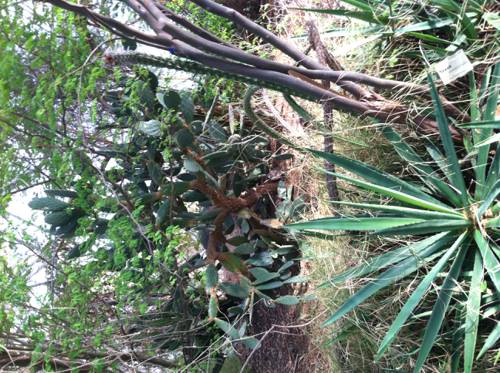
FAQ About Indoor Desert Plant Care and Cultivation

What are the main types of indoor desert plants?
Indoor desert plants mainly include varieties of cacti and succulents. Some common types are Aloe Vera, Jade Plants, Echeveria, Snake Plants, and various species of cacti like the Prickly Pear and Barrel Cactus.

How often should I water my indoor desert plants?
Desert plants such as cacti and succulents generally require infrequent watering. It is best to water them thoroughly, then allow the soil to dry completely before watering again. During the growing season (spring and summer), watering once every 2-4 weeks is typical, while in the dormant period (fall and winter), watering every 4-6 weeks may suffice.

What type of soil is best for desert plants indoors?
Desert plants thrive in a well-draining soil mix, which is crucial to prevent root rot. A cactus or succulent soil mix with a combination of materials like peat, sand, gravel, and perlite is recommended to ensure good drainage.

Can indoor desert plants thrive without direct sunlight?
While many desert plants prefer bright, direct sunlight, some can adapt to indirect light conditions. Place your desert plants near a south or west-facing window to maximize sunlight, or use grow lights if natural light is insufficient.

How can I tell if my desert plant needs water?
To check if your desert plant needs water, insert your finger into the soil about an inch deep. If the soil feels dry, it is time to water. Additionally, watch for signs like shriveled leaves as an indicator of dehydration.

How do I prevent my indoor desert plant from getting too much water?
To avoid overwatering, always allow the soil to dry out completely between waterings. Use pots with drainage holes and a well-draining soil mix. If you notice water pooling at the bottom of the pot, ensure excess water is drained away.

What is the ideal humidity level for indoor desert plants?
Desert plants prefer low humidity environments. A humidity level around 30-40% is ideal. You can maintain this level by using dehumidifiers or ensuring adequate air circulation.

Can I fertilize my indoor desert plants, and if so, how often?
Yes, you can fertilize your desert plants, but they have minimal nutrient requirements. Consider using a diluted cactus or succulent fertilizer once a month during the growing season (spring and summer) and avoid fertilizing in the dormant season (fall and winter).

Why are the leaves on my succulent dropping?
Leaf drop in succulents can be caused by overwatering, underwatering, or a sudden change in environment. Check the watering schedule, and ensure the plant is in a stable, well-lit area with the appropriate temperature and humidity.

How do I repot an indoor desert plant?
To repot a desert plant, choose a slightly larger pot with drainage holes. Gently remove the plant from its current pot, shake off excess soil, and place it in the new pot with fresh succulent or cactus soil. Water the plant lightly after repotting and place it back in its usual location.

What pests commonly affect indoor desert plants?
Common pests that may affect indoor desert plants include spider mites, mealybugs, and scale insects. Regularly inspect your plants and treat any infestations promptly with insecticidal soap or neem oil.

Can indoor desert plants survive in artificial light?
Yes, indoor desert plants can survive and even thrive under artificial lights. Use full-spectrum LED grow lights, placing them close to the plants to simulate sunlight, particularly if natural light is insufficient in your home.

Why is my cactus turning yellow?
A yellowing cactus could indicate overwatering, poor drainage, or lack of sunlight. Assess your watering routine and check for waterlogged soil. Ensure the cactus receives adequate sunlight for optimal health.

How do I propagate succulents indoors?
Succulents can be propagated through leaf or stem cuttings. Allow the cuttings to dry and callous over for a few days before planting them in well-draining soil. Keep the soil slightly moist until new roots form.

What temperature range is ideal for indoor desert plants?
Desert plants are generally comfortable in temperatures ranging from 60°F to 85°F (15°C to 30°C). Avoid extreme temperature fluctuations, particularly drafts from windows and air conditioners.

How can I tell if my indoor desert plant is unhealthy?
Signs of an unhealthy desert plant include discolored leaves (yellow, brown, or translucent), mushy stems, or a general lack of growth. Evaluate your care regimen, such as watering, lighting, and soil, to identify and correct any issues.

Do indoor desert plants need pruning?
Pruning is often necessary for desert plants to maintain their shape and remove dead or damaged parts. Clean, sharp scissors or pruning shears can be used to carefully trim back excess growth or remove dead leaves and stems.

How do I ensure my indoor desert plant gets enough airflow?
To improve airflow, place your desert plant in a well-ventilated area and avoid overcrowding it with other plants or objects. Consider using small fans to enhance circulation if needed, especially in humid environments.

Can indoor desert plants be toxic to pets?
Some indoor desert plants, like certain types of cacti, can be mildly toxic to pets if ingested. Aloe Vera is also known to be toxic to cats and dogs. It's important to research each plant and keep potentially harmful species out of reach of pets.

What are some tips for maintaining healthy indoor desert plants?
To maintain healthy indoor desert plants, ensure proper watering routine, use well-draining soil, provide adequate sunlight or artificial light, keep humidity low, and regularly check for pests. Consistent and appropriate care tailored to each species’ needs will promote growth and vitality.
